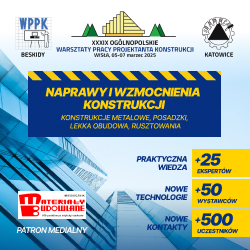mgr inż. Maciej Banach Politechnika Warszawska, Filia w Płocku,Wydział Budownictwa, Mechaniki i Petrochemii
dr hab. inż. Roman Marcinkowski, prof. Politechnika Warszawska, Filia w Płocku,Wydział Budownictwa, Mechaniki i Petrochemii
Autor do korespondencji e-mail : Ten adres pocztowy jest chroniony przed spamowaniem. Aby go zobaczyć, konieczne jest włączenie w przeglądarce obsługi JavaScript.
DOI: 10.15199/33.2016.06.02
W artykule przedstawiono zagadnienia dotyczące możliwości usprawnienia techniki harmonogramowania robót budowlanych przez dodatkowe przedmiary kosztorysowe. Problemami podstawowymi są struktura procesów znormalizowanych i sposób przedmiarowania; w dostosowaniu do stopnia szczegółowości harmonogramu – szczegółowości struktury podziału pracy.Wcelu rozwiązania tych problemów zaproponowanomodel złożonej pozycji kosztorysowejwykorzystującej dowolną liczbę jednostek przedmiarowych. Pozwala to na uzupełnianie baz danych nakładów rzeczowych o roboty odnoszące się bezpośrednio do zadań występujących w strukturze podziału pracy w harmonogramowaniu, co automatyzuje proces tworzenia harmonogramów.
Słowa kluczowe: kosztorysowanie budowlane, harmonogramy budowlane, struktura podziału pracy, przedmiary dodatkowe.
* * *
Scheduling construction works using additional quantities in costing
The aim of the study is to present possibility of improving the scheduling technique of construction works through additional cost estimate takeoffs. The basic problems in this respect include the structure of the normalised processes and the way of takeoffs; in adapting to the level of the schedule details – the details of the work division structure. The solution of these problems propsoed the model of the complex cost estimate positionmodel using any number of takeoff units. This allows for the replenishment of databases of physical inputs with work directly related to tasks occurring in the work division structure in scheduling, what automates the process of scheduling.
Keywords: construction cost estimation, construction schedules, work division structure, additional quantities.
Literatura
[1] Bakry Ibrahim, Osama Moselhi, Tarek Zayed. 2014. „Optimized acceleration of repetitive construction projects”. Automation in Construction 39: 145-151.DOI 10.1016/j.autcon.2013.07.003.
[2] Chen Po-Han, Seyed Mohsen Shahandashti. 2007. „Simulated annealing algorithmfor optimizing multi-project linear scheduling with multiple resource constraints”. Proceedings of the 24th International Symposium on Automation & Robotics in Construction (ISARC 2007), Construction Automation Group. I.I.T. Madras: 429 – 434.
[3] El-Gafy Mohamed A. 2007. „Resource Allocation for Repetitive Construction Schedules: An Ant Colony Optimization Approach”. Proceedings of the ASC 43rd Annual International Conference. Flagstaff, Arizona.
[4] GeorgyMaged E. 2008. „Evolutionary resource scheduler for linear projects”. Automation in Construction 17 (5): 573 – 583.DOI 10.1016/j.autcon. 2007.10.005.
[5] Harmelink David J., James E. Rowings. 1998. „Linear SchedulingModel: Development of Controlling Activity Path”. Journal of Construction Engineering andManagement 124 (4): 263 – 268. DOI 10.1061/(ASCE)0733-9364(1998)124:4 (263).
[6] Liu Shu-Shun, Chang-Jung Wang. 2007. „Optimizationmodel for resource assignment problems of linear construction projects”. Automation in Construction 16 (4): 460 – 473. DOI 10.1016/j. autcon. 2006.08.004.
[7] Mattila Kris G., Dulcy M. Abraham. 1998. „Resource Leveling of Linear Schedules Using Integer Linear Programming”. Journal of Construction Engineering and Management 12 (3): 232 – 244. DOI 10.1061/(ASCE)0733-9364 (1998)124:3(232).
[8] NassarKhaled. 2005. „EvolutionaryOptimization of Resource Allocation in Repetitive Construction Schedules”. ITcon 10: 265 – 273.
Otrzymano: 08.04.2016 r.
Materiały Budowlane 06/2016, str 6-10 (spis treści >>)































